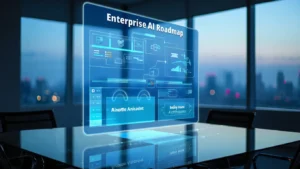AI for Logistics Data Analytics and Insights
Over $8 trillion in global logistics drives economic development and efficiency. The logistics industry has several obstacles that might impede its operations. Logistics firms must manage complicated supply chains, deliver on schedule, and optimize operations in the face of variable demand. Amid COVID-19, nearly 75% of organizations experienced pandemic-related supply chain interruptions, according to the Institute for Supply Management.
AI technologies like machine learning, predictive analytics, and automation might transform logistics. They may improve decision-making, simplify operations, and deliver actionable insights, reducing costs and increasing efficiency. According to McKinsey & Company, AI-driven supply chain management may cut forecasting mistakes and inventory costs by 20-50%.
AI helps the logistics sector manage complicated supply networks and fulfill changing market needs. AI in logistics data analytics and insights affects the industry and logistics operations, as this article explains.
The Role of AI in Logistics
AI technologies such as machine learning, natural language processing, and predictive analytics are increasingly being applied in logistics to enhance efficiency, reduce costs, and improve decision-making. Here are some examples of how these technologies are used in logistics:
Machine Learning
Machine learning is transforming the logistics business by allowing more informed decision-making and operational efficiency. This section investigates how machine learning algorithms are used to optimize routes and perform predictive maintenance, which has a substantial influence on delivery times and asset management.
Route Optimization
Logistics businesses rely heavily on machine learning algorithms to optimize their routes. By analyzing historical data on traffic patterns, weather conditions, and delivery times, these algorithms can identify the most efficient routes for deliveries. This optimization leads to faster delivery times and reduced fuel consumption. A notable example of this application is UPS’s ORION (On-Road Integrated Optimization and Navigation) system, which has saved the company millions of miles and gallons of fuel each year.
Predictive Maintenance
Machine learning is also used for predictive maintenance in logistics. By monitoring the condition of equipment and vehicles through data from sensors and maintenance records, machine learning algorithms can predict the chances of failure. This allows companies to perform maintenance before a breakdown happens, reducing downtime and extending the lifespan of their assets.
Natural Language Processing (NLP)
Natural Language Processing (NLP) is changing logistics organizations’ client interactions and data management. This section discusses how NLP improves communication and streamlines document processing in customer service and document processing.
Customer Service
NLP is used to enhance customer service in logistics through the power of chatbots and virtual assistants. These AI-driven tools can understand and respond to customer inquiries, provide real-time tracking information, and handle various customer service tasks. This not only improves customer satisfaction but also reduces the workload on human customer service representatives.
Document Processing
NLP is also applied in document processing within the logistics industry. It can automate the extraction of information from shipping documents, invoices, and other paperwork, significantly reducing manual data entry and errors. This automation streamlines operations and increases efficiency in handling documentation.
Predictive Analytics
Logistics planning and risk management benefit from predictive analytics. Predictive analytics is used in demand forecasting and risk management to anticipate market trends and prevent supply chain disruptions.
Demand Forecasting
Predictive analytics is critical for demand forecasting in logistics. It helps companies anticipate the demand for their products, allowing them to optimize inventory levels and reduce the risk of stockouts or overstock situations. This is particularly useful in industries with seasonal demand patterns or rapidly changing consumer preferences.
Risk Management
Predictive analytics is also used for risk management in the supply chain. It can identify potential risks such as delays, disruptions, or quality issues. By recognizing these risks early, companies can take proactive measures to mitigate them for smoother and more reliable operations.
Real-Life Examples of AI Applications in Logistics
The following examples illustrate the diverse applications of AI technologies in logistics, demonstrating their potential to transform the industry by enhancing efficiency, reducing costs, and improving decision-making.
Route Optimization – UPS
UPS uses its ORION (On-Road Integrated Optimization and Navigation) system to optimize delivery routes. ORION analyzes data on traffic patterns, weather conditions, and delivery times to determine the most efficient routes, reportedly saving the company millions of miles and gallons of fuel annually.
Predictive Maintenance – Daimler Trucks North America
Daimler Trucks uses machine learning algorithms for predictive maintenance of its fleet. The company’s Detroit Connect Virtual Technician service monitors vehicle performance and alerts fleet managers to potential issues before they become serious problems, reducing downtime and maintenance costs.
Customer Service – FedEx
FedEx has implemented chatbots powered by NLP to handle customer inquiries and provide real-time tracking information. These chatbots improve customer satisfaction by offering quick and accurate responses to common questions.
Document Processing-Maersk
Maersk, one of the world’s largest shipping companies, uses NLP to automate the extraction of information from shipping documents. This reduces manual data entry and errors, streamlining the documentation process and improving operational efficiency.
Demand Forecasting – Walmart
Walmart uses predictive analytics for demand forecasting in its supply chain. By analyzing data on sales trends, weather conditions, and other factors, Walmart can anticipate demand for products and optimize inventory levels, reducing the risk of stockouts or overstocking.
Risk Management – DHL
DHL employs predictive analytics for risk management in its supply chain. The company’s Resilience360 tool uses data analytics to identify potential risks, such as natural disasters or political unrest, and provides recommendations for mitigating these risks to ensure smooth and reliable operations.
Data Analytics in Logistics
Data analytics has become an essential component in the logistics sector, allowing businesses to make more informed choices and improve their operations. The use of artificial intelligence (AI) to data analytics expands its capabilities by giving deeper insights and detecting patterns in vast datasets.
Significance of Data Analytics in Logistics
Improved Decision-Making
Data analytics provides logistics companies with valuable insights into their operations, helping them make informed decisions. By analyzing data from various sources, such as GPS tracking, shipment records, and customer feedback, companies can identify trends, forecast demand, and optimize routes.
Cost Reduction
Analyzing data, logistics companies can identify inefficiencies in their operations, such as underutilized routes or vehicles, and take steps to reduce costs. For example, route optimization can lead to significant fuel savings and reduce wear and tear on vehicles.
Enhanced Customer Experience
Data analytics allows companies to track shipments in real time, providing customers with accurate delivery estimates and updates. This transparency can lead to increased customer satisfaction and loyalty.
Risk Management
By analyzing historical data, logistics companies can identify potential risks, such as weather-related delays or supply chain disruptions, and develop strategies to mitigate these risks.
How AI Enhances Data Analytics in Logistics
Pattern Recognition
AI algorithms can analyze large datasets to identify patterns that may not be immediately apparent to humans. For example, machine learning can be used to predict peak shipping times based on historical data, allowing companies to allocate resources more effectively.
Predictive Analytics
AI can be used to forecast future trends and demand, enabling logistics companies to plan ahead and optimize their operations. For example, AI can predict potential delays in shipments due to weather conditions or traffic congestion.
Automated Decision-Making
AI can automate decision-making processes, such as route optimization or inventory management, reducing the need for human intervention and increasing efficiency.
Anomaly Detection
AI can help identify anomalies in data that may indicate issues such as fraud or theft. By detecting these anomalies early, companies can take corrective action to prevent losses.
Essentially, data analytics plays a vital role in the logistics industry, enabling companies to make informed decisions, reduce costs, and enhance customer satisfaction. The integration of AI into data analytics further enhances its capabilities, providing deeper insights, predictive analytics, and automated decision-making.
Challenges and Considerations
Integrating AI into logistics presents a host of challenges and considerations that organizations must navigate to ensure successful implementation. One of the primary challenges is the high cost of integration. AI systems are typically customized for specific logistics operations, requiring significant investment in hardware, software, and training. This can be a substantial financial burden, especially for smaller companies.
Key challenges and considerations include:
- Cost of Integration: The customization and implementation of AI systems in logistics can be expensive, requiring significant investment in technology and training.
- Data Security and Privacy: AI systems process vast amounts of sensitive data, raising concerns about data security and privacy. Ensuring the protection of this data is very important.
- Human Oversight: Maintaining a balance between AI automation and human expertise is essential. AI should complement human decision-making, not replace it.
To address these challenges, companies must focus on several key areas for successful AI integration:
- Data Quality: The effectiveness of AI in logistics depends on the quality of the data. Accurate and complete data is essential for AI systems to make informed decisions.
- Algorithm Selection: Choosing the right algorithms and models is imperative so that AI systems can accurately predict trends and optimize operations.
- Continuous Monitoring: AI systems require ongoing monitoring and maintenance to ensure they are functioning correctly and to address any issues that may arise.
While the integration of AI into logistics offers significant potential benefits, it also presents several challenges that must be carefully considered. Organizations need to invest in the right technology, ensure data security, maintain human oversight, and focus on data quality and continuous monitoring to successfully implement AI in their logistics operations.
Future Trends
The future of logistics is being shaped by several emerging trends, driven by advancements in artificial intelligence (AI) and other technologies. These trends are expected to revolutionize the industry, improving efficiency, reducing costs, and enhancing customer satisfaction.
One of the most significant trends is the use of autonomous vehicles for last-mile delivery. Equipped with advanced sensors and cameras, these vehicles can navigate complex urban environments and deliver packages directly to customers’ doorsteps without human intervention. This not only speeds up the delivery process but also reduces labor costs and the potential for human error.
Blockchain technology is another trend that is gaining traction in logistics. By providing a secure and transparent way to track transactions and the movement of goods, blockchain enhances the security and efficiency of supply chains. It allows all parties involved in the supply chain to access real-time information, ensuring greater transparency and trust among stakeholders.
The Internet of Things (IoT) is also transforming logistics operations. With the proliferation of connected devices, logistics companies can collect and analyze real-time data on various aspects of their operations, from vehicle location and condition to inventory levels and environmental conditions. This data can be used to optimize routes, predict maintenance needs, and improve overall supply chain efficiency.
These emerging trends in AI and logistics are set to drive significant innovation in the industry. As technology continues to evolve, we can expect to see even more advanced applications of AI in logistics, further enhancing the speed, accuracy, and cost-effectiveness of logistics operations.
Conclusion
The integration of AI and emerging technologies like autonomous vehicles, blockchain, and IoT is revolutionizing the logistics industry. These advancements are enhancing efficiency, improving customer satisfaction, and driving innovation in supply chain management. As we look to the future, it’s clear that embracing these technologies will be key to staying competitive and meeting the ever-evolving demands of the global market.
If you are ready to take your logistics operations to the next level, contact RTS Labs today to discover how our cutting-edge AI solutions can transform your supply chain and drive your business forward. Let’s innovate together and pave the way for a smarter, more efficient future in logistics.






